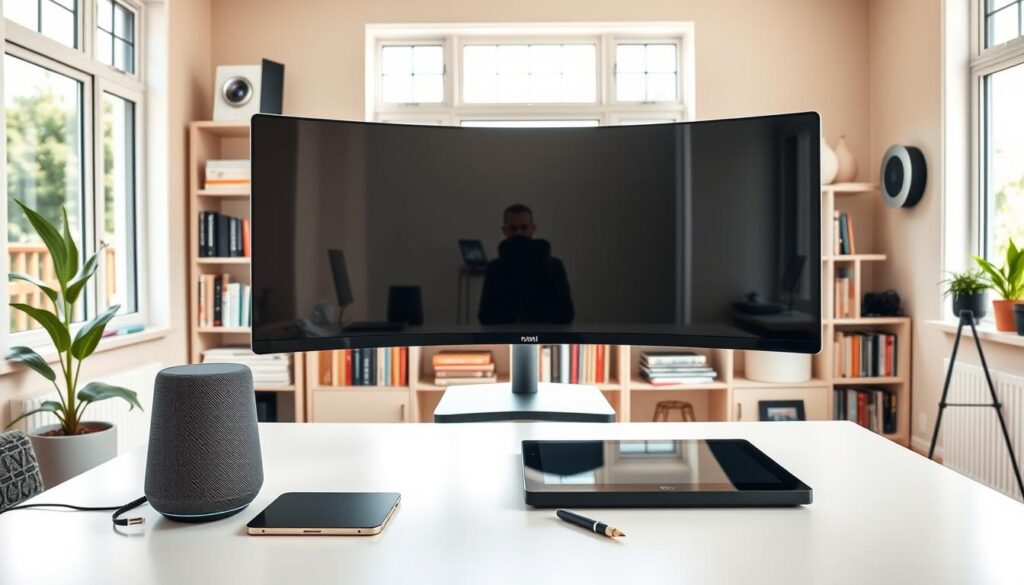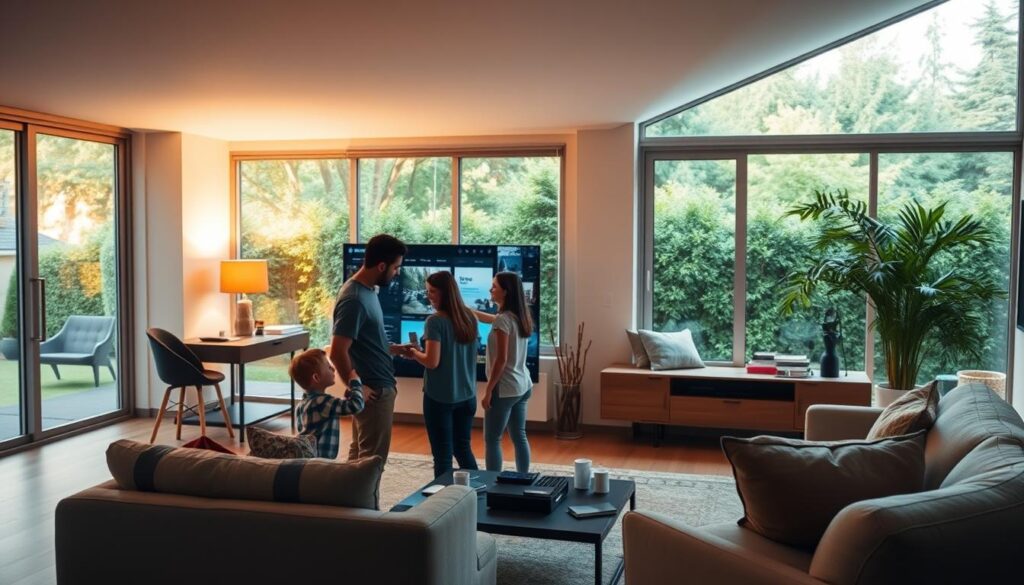Are you wondering how to strike the right balance between technology use and family time in your home today?
In today’s digital age, technology has become an integral part of our daily lives, impacting almost every aspect of our family’s routines. As a parent, it’s natural to feel concerned about the effects of screen time on your children.
Creating a tech-positive space doesn’t mean eliminating technology altogether; it’s about fostering a healthy relationship between your family and digital tools. By doing so, you can help your children navigate the digital world responsibly and thrive in a world where technology continues to evolve.
Understanding the Tech-Positive Approach
Creating a tech-positive home environment starts with understanding the philosophy behind it. As parents, we need to be intentional about how we integrate technology into our family life.
What Does “Tech-Positive” Really Mean?
A tech-positive approach recognizes that technology is an essential part of modern life. It’s about using technology in a way that enhances our lives, rather than controlling us. This means setting boundaries, prioritizing quality content, and encouraging active use of technology.
By being tech-positive, we’re not avoiding technology, but rather teaching our children to use it as a tool for learning, creativity, and connection.
The Difference Between Tech-Positive and Tech-Permissive
While a tech-permissive approach allows unlimited and unmonitored access to technology, a tech-positive approach establishes clear boundaries and expectations. Tech-positive parents model a healthy relationship with technology themselves, showing that digital tools should enhance family life, not replace face-to-face interactions.
| Characteristics | Tech-Positive | Tech-Permissive |
|---|---|---|
| Access to Technology | Monitored and Limited | Unlimited and Unmonitored |
| Content Quality | Prioritizes Educational Content | No Focus on Content Quality |
| Parental Involvement | High | Low |
By understanding the tech-positive approach, we can create a home environment that supports our children’s digital literacy and overall well-being.
The Impact of Technology on Child Development
The impact of technology on child development is a multifaceted topic that encompasses both benefits and risks. As parents, it’s crucial to understand how technology can influence your child’s growth and development.
Benefits for Young Children
Technology offers numerous developmental benefits when used appropriately. For instance, interactive and age-appropriate digital content can enhance learning opportunities and improve digital literacy. Research has shown that such content can support cognitive development, problem-solving skills, and even social-emotional learning in young children. By leveraging technology effectively, parents can provide their children with access to a wealth of educational resources that can foster their overall development.
- Enhanced learning opportunities through interactive content
- Improved digital literacy from an early age
- Access to a wide range of educational resources
Potential Risks and Concerns
However, excessive or unmonitored use of technology can lead to negative outcomes. For example, excessive screen time has been linked to language delays, attention problems, and reduced physical activity in children under five. Moreover, digital devices can impact mental health, with studies showing correlations between heavy screen use and increased anxiety and depression symptoms in young children. It’s essential for parents to be aware of these risks to mitigate them effectively.
- Language delays and attention problems due to excessive screen time
- Reduced physical activity and potential long-term health consequences
- Increased risk of anxiety and depression symptoms
By understanding both the benefits and the risks, parents can adopt a balanced approach to technology use in their homes, maximizing the positive impacts while minimizing the potential harms.
Assessing Your Current Home Tech Environment
To foster a tech-positive home, it’s essential to first understand how your family interacts with technology. This involves taking a close look at your current home tech habits and identifying areas that need adjustment.
Evaluating Your Family’s Technology Use Patterns
Start by observing how, when, and why different family members use devices. Are screens primarily for entertainment, education, or communication? Notice patterns in your home: Do devices interfere with family meals or cut into physical activity or sleep? Consider conducting a “tech audit” by tracking all family screen time for a week.
Identifying Areas for Improvement
As parents, it’s crucial to pay special attention to your own technology use, as children learn more from what you do than what you say. This assessment is about gathering information to make thoughtful changes that align with your family’s values and needs. Look for both positive technology interactions to maintain and problematic patterns to address in your tech-positive plan, focusing on establishing a healthy relationship with technology and managing time effectively.
Designing a Tech-Positive Home Environment
A well-designed home environment plays a significant role in shaping children’s interactions with technology. By creating spaces that promote healthy tech habits, you can help your children develop a positive relationship with technology.
Creating Dedicated Tech Spaces
Designate specific areas for tech use, such as a family room or study area, where adults can monitor screen activities. This helps prevent excessive screen time and promotes responsible tech use.
Establishing Tech-Free Zones
Establish tech-free sanctuaries in your home, such as bedrooms and dining areas, to reduce screen time and promote better sleep and family connection. This helps create a healthy balance between tech use and other aspects of family life.
Setting Up Age-Appropriate Tech Stations
Design age-appropriate tech stations with proper ergonomics, blue light protection, and time-tracking tools to support healthy physical development. Consider a “tech check-out” system where devices are stored in a central location and “borrowed” for specific purposes.
By implementing these strategies, you can create a tech-positive home environment that supports your family’s values and promotes healthy tech habits. Your home’s physical layout should reflect your tech values, making technology accessible but not dominant in family life.

Setting Healthy Technology Boundaries
Establishing healthy technology boundaries is crucial for creating a tech-positive home environment. This involves setting clear expectations and guidelines for technology use within your family.
Developing Family Media Use Plans
Start by developing a family media use plan that reflects your values and establishes expectations for when, where, and how technology can be used. According to the American Academy of Pediatrics, parents should create “media use plans” tailored to their child’s age, health, temperament, and developmental stage.
Implementing Screen Time Guidelines by Age
Implement age-appropriate screen time guidelines. For young children under 5, the American Academy of Pediatrics recommends limiting screen time to 1 hour per day of high-quality programming, with co-viewing whenever possible.
Using Parental Controls Effectively
Learn to use parental controls effectively – not just as restriction tools but as scaffolding that gradually gives children more responsibility as they demonstrate readiness. This approach helps children develop self-regulation skills and a healthy relationship with technology.
By setting clear boundaries around technology use, you can create a tech-positive home environment that supports your child’s growth and development. Remember, the goal is to teach children to develop their own healthy relationship with technology that will serve them throughout life.
Selecting Quality Digital Content for Children
When it comes to digital media, parents face the challenge of sifting through a vast array of content to find what’s suitable for their children. The key is not just to limit screen time, but to ensure that the content consumed is of high quality and supports their development.
Evaluating Educational Apps and Programs
Not all educational apps are created equal. When evaluating apps, look beyond the “educational” label. Opt for content that encourages creativity, problem-solving, and active engagement. For instance, apps that allow children to create their own stories or solve puzzles are more beneficial than those that merely provide information in a passive manner.
Finding Age-Appropriate Entertainment
Understanding what makes digital content age-appropriate is crucial. It’s not just about the academic content, but also the pacing, complexity, and social-emotional themes. For example, content with characters and storylines that reflect a child’s real-life experiences can be very engaging and beneficial.
Resources for Content Recommendations
Utilize trusted resources like Common Sense Media, PBS Kids, and the American Library Association for vetted content recommendations. These organizations provide reviews and guidance tailored to your child’s developmental stage, helping you make informed decisions about their media consumption.
| Resource | Description | Age Suitability |
|---|---|---|
| Common Sense Media | Provides detailed reviews of apps, games, and TV shows. | All ages |
| PBS Kids | Offers educational content and games. | Preschool to early elementary |
| American Library Association | Recommends books and digital content. | All ages |
By being mindful of the content your child consumes and utilizing trusted resources, you can create a tech-positive environment that supports their growth and development.
Integrating Technology with Learning and Growth
Integrating technology with learning and growth is a vital step in creating a tech-positive home environment. By doing so, we can ensure that our children reap the benefits of technology while developing essential skills for their future.
Using Tech to Support Educational Goals
We can align tech use with our child’s educational goals by leveraging digital resources that reinforce classroom learning or explore new interests. For instance, platforms like Khan Academy offer interactive learning experiences that make education engaging and fun.
Encouraging Creative Technology Use
It’s essential to encourage children to be creators, not just consumers, of technology. By using tech for coding, digital storytelling, music composition, or art creation, we can foster their creativity and develop their problem-solving skills.
Balancing Digital and Hands-on Learning
While technology is a valuable tool, it’s crucial to balance screen-based learning with hands-on, multisensory experiences. This balance helps develop different neural pathways and skill sets, ensuring a well-rounded growth process.
By integrating technology with learning and growth, we can create a tech-positive environment that supports our children’s educational journey and overall development.
Teaching Digital Literacy and Safety
Digital literacy is no longer a luxury, but a necessity for children to thrive in an increasingly tech-positive home environment. As we continue to integrate technology into our daily lives, it’s crucial that we equip our kids with the skills to navigate the digital world safely and effectively.
Age-Appropriate Digital Citizenship Lessons
Start teaching fundamental digital citizenship concepts early, even to preschoolers. This includes understanding digital footprints, privacy, and respectful online communication. As parents, you’re the first and most influential tech teachers for your kids, setting the tone for healthy technology use.
Online Safety Fundamentals for Young Children
Develop age-appropriate safety protocols, focusing on simple rules like “ask before you download” and “only talk to people you know in real life.” Regular discussions about media messages, advertising tactics, and information reliability are also vital.
Modeling Responsible Tech Behavior
As a parent, your own habits with digital devices send powerful messages about responsible tech use. By modeling good behavior and having ongoing conversations about social media and online safety, you help your students develop into savvy digital citizens.
Balancing Technology with Physical Activity and Social Interaction
As we navigate the digital world, it’s vital to ensure that technology enhances family life without dominating it. A tech-positive home maintains a delicate balance between screen time and other essential childhood activities – physical play, social interaction, and unstructured exploration. To achieve this balance, families can implement various strategies that promote healthy technology use.
Incorporating Tech-Free Family Activities
Discover creative ways to incorporate regular tech-free family activities that strengthen relationships and provide necessary breaks from digital stimulation. You can create family rituals that naturally reduce screen time without making it feel like punishment – outdoor adventures, game nights, cooking together, or community service.
Using Technology to Encourage Movement
Technology itself can actually promote physical activity through movement-based games, fitness challenges, and outdoor adventure apps designed for children. For example, you can explore apps that encourage kids to get outside and be active. Check out resources on managing screen time for kids to find more ideas.
Promoting Face-to-Face Social Skills
Face-to-face social skills are critical for young children, who are still learning to read facial expressions and social cues. Encourage in-person interactions through playdates, family gatherings, and community activities. By doing so, you’ll help your children develop essential social skills that will benefit them throughout their lives.
Managing Challenges in a Tech-Positive Home
As we strive to create a balanced tech-positive home, we inevitably encounter obstacles. Managing technology in family life is an ongoing process that requires flexibility, patience, and regular reassessment as children grow and technology changes.
Dealing with Screen Time Battles
Screen time battles are a common challenge in many households. According to Pew Research, consistent, calm enforcement of boundaries works better than punitive approaches. To manage these battles effectively, it’s essential to establish clear guidelines and stick to them. This helps in creating a healthy relationship between your child and technology.
Some strategies to consider include setting up tech-free zones in the home, such as the dinner table or bedrooms, and implementing screen time limits that are appropriate for your child’s age. By doing so, you can help your child understand that technology is a tool, not a right.
Addressing Digital Content Concerns
Another challenge is addressing concerning digital content that your child may encounter. This could range from age-inappropriate material to troubling messages about body image or violence. Developing a toolkit to address these concerns is crucial. This might involve having open conversations with your child about what they’ve seen online and using parental controls to filter out inappropriate content.
| Challenge | Strategy | Benefit |
|---|---|---|
| Screen Time Battles | Consistent boundaries, tech-free zones | Reduces conflict, promotes healthy tech use |
| Digital Content Concerns | Open conversations, parental controls | Protects children from harmful content, fosters trust |
| Technology Overuse | Regular breaks, digital detox days | Reduces stress, promotes balance in life |

By being proactive and adaptable, you can create a home environment where technology enhances your child’s development and family connection. Remember, the goal isn’t perfection but progress.
Conclusion: Nurturing Digital Citizens in a Connected World
By thoughtfully managing technology in our homes, we can foster a positive digital culture for our children. This involves creating a tech-positive home environment that balances technology use with other aspects of family life. As you continue on this journey, remember that the goal is to raise children who understand that technology should enhance human connection, creativity, and learning.
For more resources on supporting your child’s digital growth, visit Lunesia’s Early Literacy at Home page. By staying flexible and informed, you’ll help your child develop a healthy relationship with technology that supports their overall well-being and prepares them for an increasingly connected future.
FAQ
How can I create a healthy relationship with technology in my household?
To foster a healthy relationship with technology, it’s essential to set clear boundaries around its use. This includes establishing tech-free zones, implementing screen time guidelines, and modeling responsible tech behavior for your children.
What are some effective ways to reduce screen time for my child?
Reducing screen time can be achieved by encouraging physical activity, promoting face-to-face social skills, and incorporating tech-free family activities into your daily routine. You can also use parental controls to limit screen time and monitor your child’s technology use.
How can I ensure that the digital content my child consumes is age-appropriate?
To ensure that your child is consuming age-appropriate digital content, evaluate educational apps and programs carefully, and look for resources that provide content recommendations. You can also use parental controls to filter out mature content.
What are some ways to integrate technology with learning and growth?
Technology can be a valuable tool for learning and growth when used effectively. You can use tech to support educational goals, encourage creative technology use, and balance digital and hands-on learning to provide a well-rounded education.
How can I teach my child about digital literacy and safety?
Teaching digital literacy and safety is crucial in today’s connected world. You can start by providing age-appropriate digital citizenship lessons, teaching online safety fundamentals, and modeling responsible tech behavior.
What are some strategies for managing challenges in a tech-positive household?
Managing challenges in a tech-positive household requires dealing with screen time battles effectively, addressing digital content concerns, and staying up-to-date with the latest technology trends and research.




